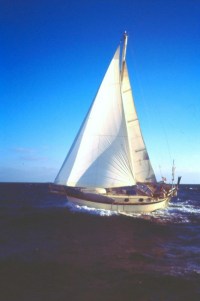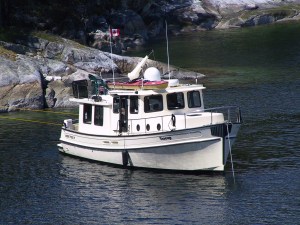Actually, this is a chronology of past boats and experiences as well as an introduction to my new boat.
"Selene", Crealock 31
Somewhere in the
Pacific, 1988
I started sailing in 1987, when I bought a 31-foot Crealock "Mariah," with the intention to learn how to sail it and then sail it solo around the world.
But, unlike 99% of those who plan a sail around the world, I actually did it. I sailed my little boat for four years through the tropics, completing a solo circumnavigation and having all kinds of wild adventures.
Read the full story in my book
"Confessions of a Long-distance Sailor,"
a free download from this site.
Tropical sailing, sailing in the tradewind belt, is a practical sort of sailing, because tradewinds are very reliable. The weather is usually nice and the wind might well blow the same speed and direction for weeks at a time. I can remember sailing very long stretches with minor adjustments to my sail plan, enjoying the consistency of the tropical conditions.
The other advantage to sailing for years in the tropics is you find out what is important, or, more to the point, what is not important. I won't presume to tell you what is important, since that would be garden-variety rude, but I can tell you what is not important — everything else. When you sail across the ocean for months, when you watch the sea's moods change in fascinating ways, something funny happens. You find youself hoping it won't end, hoping that all the earth's land will disappear and relieve you of any responsibility for actually getting somewhere, of arriving, of having it end.
After my around-the-world sail, I bought a sailboat that would have been a better choice for long-distance sailing, a Crealock 37. This was the boat I should have sailed around the world, if only I had known more than I did when I was planning the trip and buying my first boat.
I operated "Entropy" for four years in the Pacific Northwest, mostly going on expeditions to British Columbia and Southeast Alaska. Unlike my time in the tropics, in the northwest I found myself motoring most of the time, rarely under sail, something I discovered is the normal condition for sailboat owners in this area, because of the light and inconsistent winds.
"Entropy", Crealock 37
Knight Inlet, B.C., 2001
But there is something very important to understand about owning a sailboat. It doesn't matter if you never actually put up the sails, because simply owning a sailboat makes you a real sailor, a superior being. By contrast, power boat operators are looked on as sellouts, as creatures lower down on the evolutionary tree. This kind of talk is silly, of course, but so are most of the ways we set ourselves apart from the people around us.
But there actually are differences between sailboat and power boat owners, something I can fairly comment on, having owned both sailboats and power boats. One difference is that sailboat owners are more likely to willingly take a wave in the face, or put up with rough water in exchange for a nice brisk wind and a fast sail. Power boat owners much prefer flat, calm water, in fact some of the faster power boats simply break if you try to take them through rough conditions. My experience is sailboats and their owners care less about rough water.
Another difference is a power boat operator is much more likely to create a huge, dreadful wake that he may be totally unaware of, simply because of the higher speed of the power boat, a wake that might propagate through an anchorage and annoy everyone. This is a very common occurrence, and it is simply bad seamanship. I can't count the number of times I've heard someone get on the radio to tell off a power boat for rocking all the boats within range of his wake — or dangerously swamping a small fishing boat — while racing to the next natural attraction.
Because I spend a lot of time in my kayak, I really know how severe a big wake can be, which has sensitized me to this issue.
But I digress. During 2001 I made a long cruise through British Columbia and Southeastern Alaska. My sailboat had an open cockpit and I had been cold and wet most of the season, I had been under sail about two hours in four months, and by the time I ended the cruise I had decided to change boats.
"Teacup", Nordic Tug 37
Hardy Island, B.C., 2002
I shopped around for a while and settled on a boat of American manufacture that has a good reputation — a "Nordic Tug." Despite the cute name, it is not really a tugboat or a boat meant for the open ocean, although it can be safely operated there if one is careful. Having said that, I realize the same thing could be said of nearly any boat.
Boats like the Nordic Tug have a relatively flat bottom, which makes them more efficient in going from place to place in comparatively calm conditions, but this hull shape makes them less safe in rough seas than a slower, more traditional, deep-keel boat would be. But in my opinion, and based on one season's experience, the Nordig Tug is a decent compromise between performance and seaworthiness. I certainly saw this boat admirably behave itself during my summer in the Gulf of Alaska, in seas that were occasionally very rough.
About the name "Teacup." I have a tendency to name my boats in relatively obscure ways, just to make interesting conversations when people ask about the name. But when I first saw the new boat at the dealership, it was shorn of any decoration and it looked like nothing so much as a big china teacup, so I said so. And what can I say — the name stuck. But hey — "Teacup" is easy to phonetically spell out on the radio, and people are much more likely to remember the name than, say, "Thalassa Experience III" (which for years was my favorite awful boat name).
In a fashion change, boats in this class now tend to have large engines, mostly so the dealers can make claims about high top speeds. This boat's top speed is 18 knots, although this requires that the boat be empty and that the skipper not pay any heed to the annoying slurping sound coming from the fuel pump.
Teacup has a 330 horsepower diesel engine, about three times more power than it actually needs for a typical voyage. But the extra power comes in handy at times, like the evening I towed a large, broken-down cabin cruiser with ten people on board back to the marina in Homer, Alaska. The other time extra power is useful is while navigating through rapids (plenty of those in British Columbia) and other rough conditions where shortening the time spent underway is a clear safety issue.
Most of the time I use a more modest power setting, travel at 9 1/2 knots and burn 5 gallons per hour, which, if you think about it, is less than the fuel burned each hour by a typical American SUV. But on the advice of a number of diesel mechanics I have talked to, I usually run the engine near full throttle for a spell each day, to prevent carbon buildup. This is the one disadvantage to having a big engine, an engine that has more power than you actually need for normal cruising — you have to think of a way to make the engine happy, and diesel engines are not happy being idled all the time.
Now that I've cruised a full season (I guess 6000 miles can fairly be called a "full season"), I really like this boat. I can comfortably move the boat in wet, gray weather, so I am free to paddle my kayak or take a hike on the occasional sunny day. It may seem like a small thing, but it's nice to have some gear, somewhere on the boat, that is not completely wet after a stretch of rainy days, something that was never true of my sailboat while in Alaska.


 Share This Page
Share This Page

 Share This Page
Share This Page





 Share This Page
Share This Page